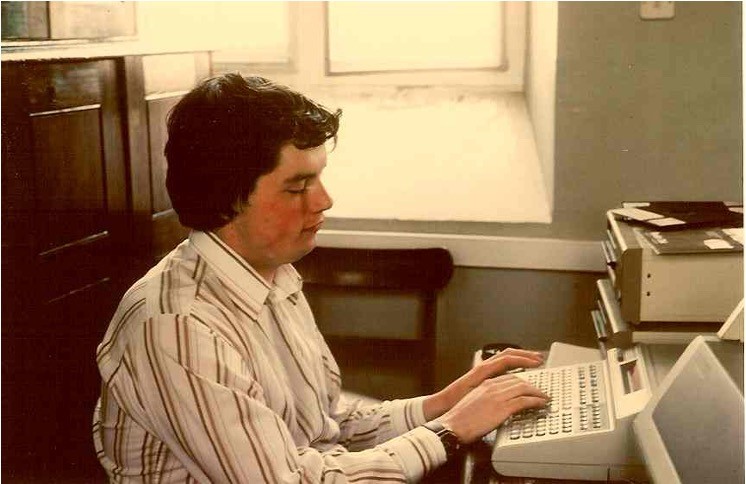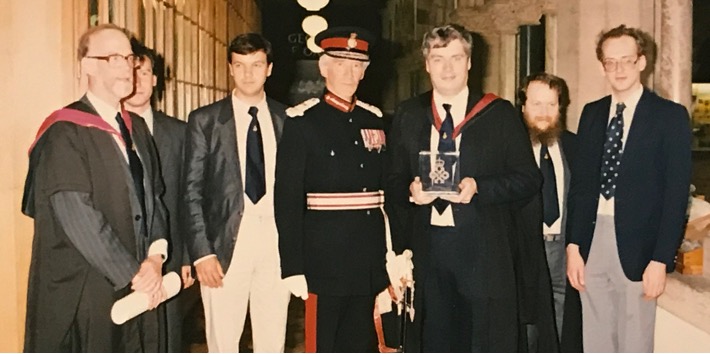Taking a punt on computer science
Posted: 30th November 2023

I came down from Dundee in Scotland to study Maths at University College Oxford (Univ) in 1975 where I found myself studying in a group of six — all men because Univ did not admit women until 1979.
By a remarkable coincidence this group included four future professors: apart from me there were Steve Brookes (now CMU), Richard Cole (NYU) and Tony Carberry (Edinburgh, and the only one who stayed in Maths rather than moving to computer science). I first set foot in the Computing Laboratory, in 1977, when I went to the Jenkin Building for tutorials in Numerical Analysis (NA). In those days NA made up most of the Computing Laboratory. The Programming Research Group (PRG) were in 45 Banbury Road, a Victorian house.
My favourite memory of my NA tutorials is going punting with some friends, being dropped off in the Parks so I could go to my tutorial and then rejoin the punt afterwards. Professor Bill RoscoeIn 1977-8 (our final undergraduate year) Steve Brookes and I decided to do the course on the Scott-Strachey approach to semantics that was given by Joe Stoy. We had experience of programming in languages like Algol and Fortran, though the only actual programming I did for that course was enumerating some finite lattices.
That same summer saw the arrival of Tony Hoare as professor, Strachey having died two years earlier, meaning that Joe was the only Computer Science academic 1975-7. Dana Scott was very much around but based in Philosophy. Steve and I enjoyed the course so much that we decided to do our doctorates in Computer Science rather than Maths, and we arrived as fresh doctoral students in the autumn of 1978, thus beginning our work on CSP with Tony. (Cole and Carberry did their doctorates in USA.) Tony and Joe were the only academics in PRG, and there were support staff including Malcolm Harper who had been Strachey’s research assistant and stayed in the department for 40 years until 2010. There were a couple of research assistants including Bernard Sufrin, who had arrived at the same time as me, Steve and Geraint Jones, who was also my undergraduate contemporary though at a different college.

That same year PRG moved to 8-11 Keble Road, by then Tony was much involved with Inmos, the then great hope for a British microprocessor industry, and so I, and other colleagues became much involved in the Transputer and Occam. I worked closely with Inmos till 1992 including on the T800 FPU verification, which won the department its first Queen’s Award for Technological Achievement in 1990.
Expanding computer science
The first big opportunity for departmental expansion came in 1983 and the following few years with the Alvey Programme. The first tranche brought four new lecturers, trebling the number of Computer Science academics to six. These were me, Bernard Sufrin, Richard Bird carrying on the functional programming tradition, and Ib Sorensen in industrial formal methods. The establishment of the undergraduate degree of Mathematics and Computation in 1985 led to a slow but steady trickle of appointments to Tutorial Fellowships.
By about 1989 the department (PRG and NA) had outgrown 8-11 Keble Road, and so we adopted an annexe (affectionately or maybe not) known as Tasmania, in South Parks Road. This convinced all of us who were around that it was far better to be on one site. This became true again in 1994 with the opening of the Wolfson Building. The number of degrees was growing: the Software Engineering Programme grew out of a big formal methods collaboration with IBM on the CICS transaction system that had led to the department winning its second Queen’s Award in 1991. We set up the Computer Science undergraduate degree in 1994.
I have been closely involved in setting up many Oxford undergraduate degrees: all those of CS plus the four year Maths degree (as CS representative) and Mathematics and Statistics (which I pushed along as Faculty Board Chairman).
The range of topics addressed by our researchers slowly grew so that by the end of the 1990s we had a flourishing group in security, one in requirements, the very beginnings of one in Computational Biology and, with Richard Brent, one in Algorithms.
Meanwhile Tony, who had never been seen to touch an actual computer at work for many years (his secretary had printed out all his emails and he had written his replies on them in his inimitable longhand) began to take an interest in a computer Microsoft had given him. It was therefore less of a surprise than it might have been when he retired from Oxford in 1999 and moved to Microsoft. By this time, I was running the Mathematical Sciences faculty as its last-ever faculty board chairman (a semi- executive position) and we appointed Samson Abramsky to replace him.
While always rooted in concurrency, my own work moved in the 1990s from hardware verification to model checking (FDR) and security. I was always inspired by Strachey’s maxim that theory should not be done without practice in mind, and all practice should be informed by theory. Thus, much of my theoretical work has been inspired by industrial need, and my initial theoretical research into modelling concurrency has gradually been reduced to Engineering practice.
Lasting change
In 2003, I became Head of Department (HoD) just after the University restructuring (divisionalisation) that gave more autonomy to departments. I was able to take advantage of this in growing the department. My vow when I became HoD was to grow from being an unnaturally small department to being the size an outsider would expect. My first big job was the e-Science building project but the most lasting change, which some resented, was changing the department’s name from Computing Laboratory to Department of Computer Science. This was part of a long-standing campaign to get proper recognition for Computer Science at Oxford, because at the time many in Oxford did not know their university had a computer science department. The process towards recognition has been rapidly advanced in recent years, thanks to the huge demand for undergraduate places and the consequent need for Tutorial Fellows.
I continued as HoD until 2014 and made two other structural changes under my Headship. The NA group, which had gained an increasingly mathematical focus under Nick Trefethen, migrated to the Mathematical Institute, and the Software Engineering programme became fully owned by CS after being a joint venture with Continuing Education.
Head of Department is an extremely taxing job and does not allow much time for one’s own research. However, I did manage to write my second book on CSP during the sabbatical year in the middle, and moved my security focus to non-standard authentication. As HoD I had the support of many wonderful academics, but I want to highlight the support from the dedicated and inspired team of support staff led by Sharon, particularly in the second half of my tenure. More recently I supported Philippa Hopcroft and Tom Gibson-Robinson in their astonishingly successful creation of the Coco System and the associated company Cocotec, and went part-time to enable me to do fundamental research on Blockchain outside the department.
My university research has continued to develop new directions in security protocols thanks to delay encryption. I rediscovered this and exploited it to eliminate cheating by selective non-performance in multi-party protocols such as fair exchange.
Retirement
My immediate aim in retirement is to write another book detailing my perspective on the decentralised world such as Blockchain: Understanding Decentralised Systems . The title, at least, is inspired by my book Understanding Concurrent Systems. In my view the world will increasingly rely on such systems, so that getting to grips with them and knowing when to trust them is one of the most important challenges we face. Like AI, it is a highly interdisciplinary domain, impacting ethics and the social structures of the world.
I have had the huge privilege of working in this department for 45 years and being a regular academic for 40. Professor Bill RoscoeIn the old days we seemed to have complete freedom in our collaborations, and I got to know so many of the world’s leading scientists. As the years have progressed, we have been more and more constrained by rules imposed by a risk-averse university that makes it hard to do anything unusual in areas such as industrial collaboration, setting up companies and fundraising. Similarly, our freedoms regarding teaching diminish and we have to spend much time on the minutiae of governance. I shall be pleased not to be worrying about these things anymore when I retire just after my 67 th birthday.
